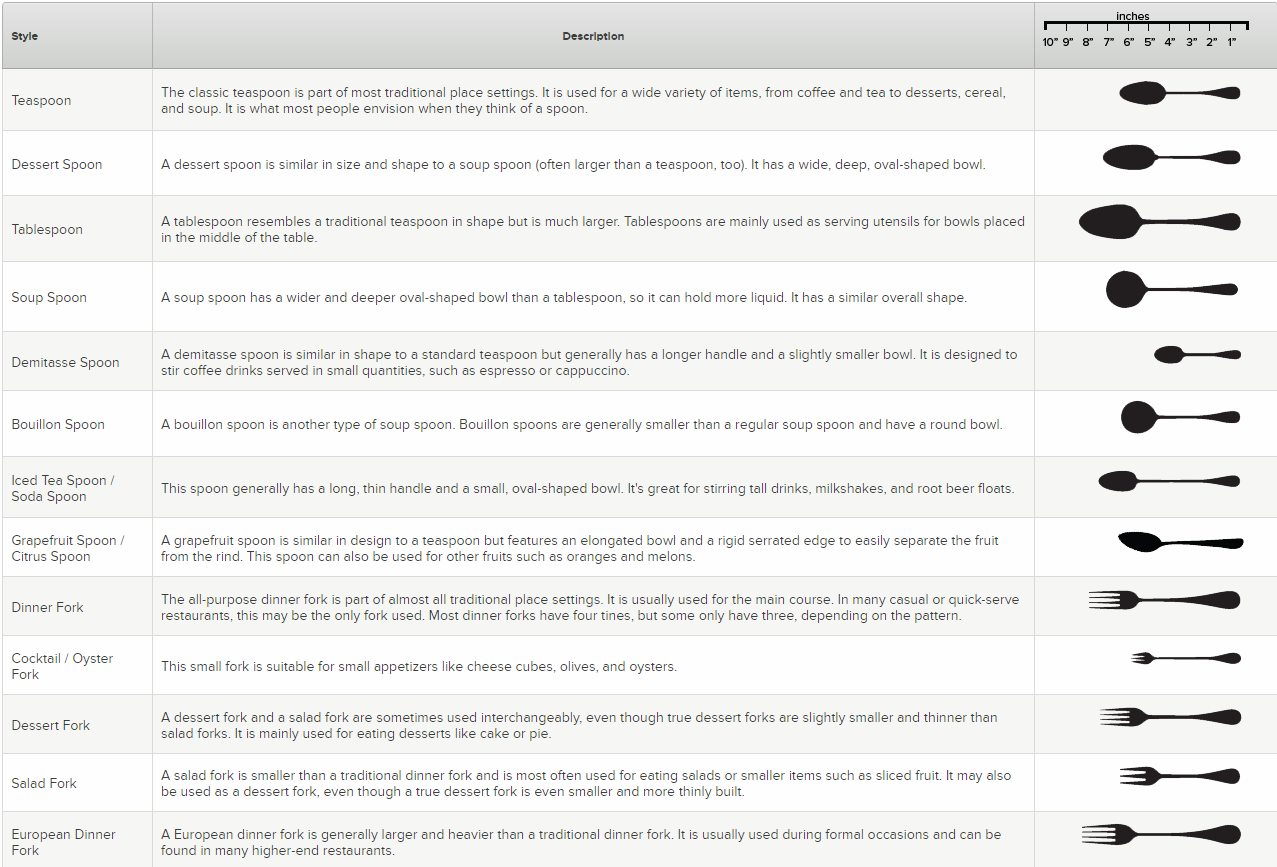Types of Flatware
Spoons, forks, and knives are the three basic types of flatware, but did you know that there are multiple types of each utensils for different applications? This buying guide will go through the various purchasing considerations for flatware, such as stainless steel flatware grades, types of flatware, and each type’s application so that you can choose the best flatware for your establishment.

What Is Flatware?
Flatware is a term that is used to group together different utensils, including spoons, forks, and knives, that are used at the table for eating and serving rather than as kitchen tools. Flatware is most commonly made with stainless steel, which is best for everyday use since it’s affordable, durable, and easy to care for. Flatware can also be made of sterling silver, which is where the term silverware comes from. Silverware is not recommended for commercial use due to its level of high maintenance and high price tag.
Types of Stainless Steel Flatware
There are four different grades of stainless steel flatware: 18/0, 18/8, 18/10, and 13/0. These designations refer to the percentages of chromium and nickel in the stainless steel alloy. Chromium is used in stainless steel to provide durability as well as resistance to rust and corrosion, while nickel is used to give flatware its luster.
What Does 18/10 Stainless Steel Mean?
18/10 stainless steel contains 18% chromium and 10% nickel.
What Does 18/8 Stainless Steel Mean?
18/8 stainless steel contains 18% chromium and 8% nickel.
What Does 18/0 Stainless Steel Mean?
18/0 stainless steel contains 18% chromium and 0% nickel. 18/0 flatware is magnetic, which makes it a good choice if you use magnetic flatware retrievers at your business.
What Does 13/0 Stainless Steel Mean?
13/0 stainless steel contains 13% chromium and 0% nickel. Most dinner and dessert knives are made with 13/0 stainless steel. This steel is ideal for blade forging to produce a sharp cutting surface, while still maintaining rust- and corrosion-resistant properties.
18/8 vs 18/10 Stainless Steel
18/10 stainless steel is made with 2% more nickel than 18/8 stainless steel, making it more durable and more resistant to bending as well as more resistant to corrosion. 18/10 stainless steel flatware also has more of a luster and shine than 18/8, making it the premium choice of flatware for fine dining establishments. 18/8 stainless steel flatware is a more affordable option while still delivering durability and corrosion resistance.
18/10 vs 18/0 Stainless Steel
18/0 stainless steel has 0% nickel, making it less durable, shiny, and resistant to corrosion than 18/10 stainless steel. 18/0 stainless steel flatware is an affordable option that’s suitable for dining halls or fast-casual restaurants where there is a higher risk of flatware being lost or stolen.
What Is the Best Quality Stainless Flatware?
18/10 flatware is the best quality stainless steel flatware. Typically of the extra heavy weight variety, 18/10 flatware feels sturdy in the hand, and it is more difficult to bend, making it a long-lasting flatware choice. Plus, the 10 percent nickel gives it more of a shiny luster and enhanced corrosion protection.
Keep in mind that the grades of stainless steel do not refer to the thickness (or gauge) of the flatware, which is what determines the weight. The higher the gauge, the thicker / heavier the flatware is.
Flatware Weight
Restaurant flatware comes in four different weights: forged, extra-heavy, heavy, and medium weight. Read on to learn about each flatware weight so you can decide which is best for your business.
1. Forged Flatware:
Forged flatware is the thickest and strongest type of flatware. It is made from a single piece of thick stainless steel which creates a pattern on all sides of the handle rather than just stamped on the top. It is extremely durable and built to withstand any commercial environment, while also fitting in well with upscale dining.
2. Extra Heavy Weight Flatware:
As our premium grade of flatware, extra heavy weight flatware exudes a level of quality that you will see at finer restaurants and hotels. It feels very sturdy in your hand and is very difficult to bend, compared to medium or even heavy-weight flatware.
3. Heavy Weight Flatware:
Heavyweight flatware is more durable than medium-weight flatware, not easily bent, and makes for a nice presentation. As a definitive step-up in quality from medium weight, it is commonly used in fast-casual dining establishments and many other mid-level eateries.
4. Medium Weight Flatware:
Medium weight flatware is the lightest flatware that we carry. This is primarily called medium-weight flatware in the industry, but it can also be called economy weight and is commonly sought by the value-minded buyer. Medium-weight flatware is often bendable in your hand and commonly found in cafeterias, schools, and other institutional settings.
Types of Flatware and Their Uses
Now that you understand flatware quality and weight, the next step in choosing flatware is learning the types of flatware and their uses. There are multiple sizes and styles of spoons, forks, and knives; and the chart below will walk you through each type we have available.


How to Clean Stainless Steel Flatware
Whether you’re using a three-compartment sink or a commercial dishwasher, stainless steel flatware will last longer and look better if you keep the following tips in mind:
- Remove all food remnants from your flatware as soon as possible.
- Sort and handle properly. It’s a good idea to sort the tines, blades and bowls down if you transport and wash flatware in the same cylinders. When washing in the flatware cylinders, it’s a good idea to mix up the flatware so forks and spoons don’t “nest” and to wash with the business end up.
- Presoak for approximately 20 minutes. Noble Chemical’s Silva Soak presoak powder is a great choice for presoaking your stainless steel flatware. This concentrated powder penetrates and saturates soils for more effective removal in your wash cycle.
- Don’t forget to change your soaking solution after a few cycles; otherwise, chemicals and food particles will accumulate and reduce its effectiveness.
- Like all stainless steel, hard water and detergents high in chlorides will eventually break down the protective film. As long as you follow proper presoaking and drying procedures and your dish machine is rinsing correctly, any high-quality detergent and sanitizer should not harm your flatware.
- To ensure your flatware always looks its best, be sure to polish immediately with a microfiber cloth or mitt, eliminating any water spots or smudges.
If you want to know more about outdoor weddings, please click this: What Is a Charger Plate?
